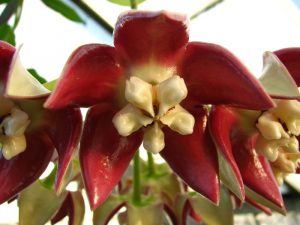This week, succumb to the warmth of the Lowland Tropics and seek out the stunning Hoya imperialis. Native to Malaysia and Indonesia, this tropical gem produces the largest flowers of the genus.
Growing in a pot of open bark/cork/charcoal mix, our 2003 introduction is currently in flower. The thick supporting stem is twining above head-height in the north east corner of the Lowland Tropics glasshouse. Hanging down from the horizontal growth is a crown composed of eleven individual flowers attached by long flexed pedicles.
Each solid, waxy bloom is composed of green sepals, petals; rusty red inside, creamy white above and with very prominent (also creamy white) corollas. The ants seen moving all over the flowers are attracted to the nectar held within the floral parts. Reports say that there is a sweet fragrance in the evening and early morning, but there is no evidence of it from this flower.
Below is a section from the report Glasshouse Supervisor Louise Galloway wrote on her return from Sabah, Borneo in October 2006. Note the last sentence. The result can be observed in the successful flowering of our specimen.
En route to Mt. Kinabalu we stopped off for a break at the home of orchid enthusiast Ben Chai. His garden was a riot of colour with many species of orchids; Oncidium, Paphiopedilum and Phalenopsis, an epiphyte lovers’ delight with Hoya and Aeschynanthus literally dripping off purpose built posts.
He had an innovative way of growing Hoya (Asclepiadaceae family), that he assured me guaranteed flowering. This really intrigued me as we have a large collection of Hoya sp. at the RBGE and many are not yet formally identified so I really want to get them to flower to allow for scientific verification. Large pots were placed at the bottom of an upturned tree fern trunk filled with an epiphytic mix comprising chunks of Asplenium nidis, sustainably sourced of course, alongside sections of tree fern and charcoal chunks for the potash content, therefore it was incredibly free draining. As soon as the plants had reached the top of their pole they are trained horizontally along wire that links all the poles together – as soon as they start to grow horizontally they start to flower! Proof of the pudding as they say…..I have tried this method since returning home with great success


hoya enthusiast
native to Malaysia and Philippines..